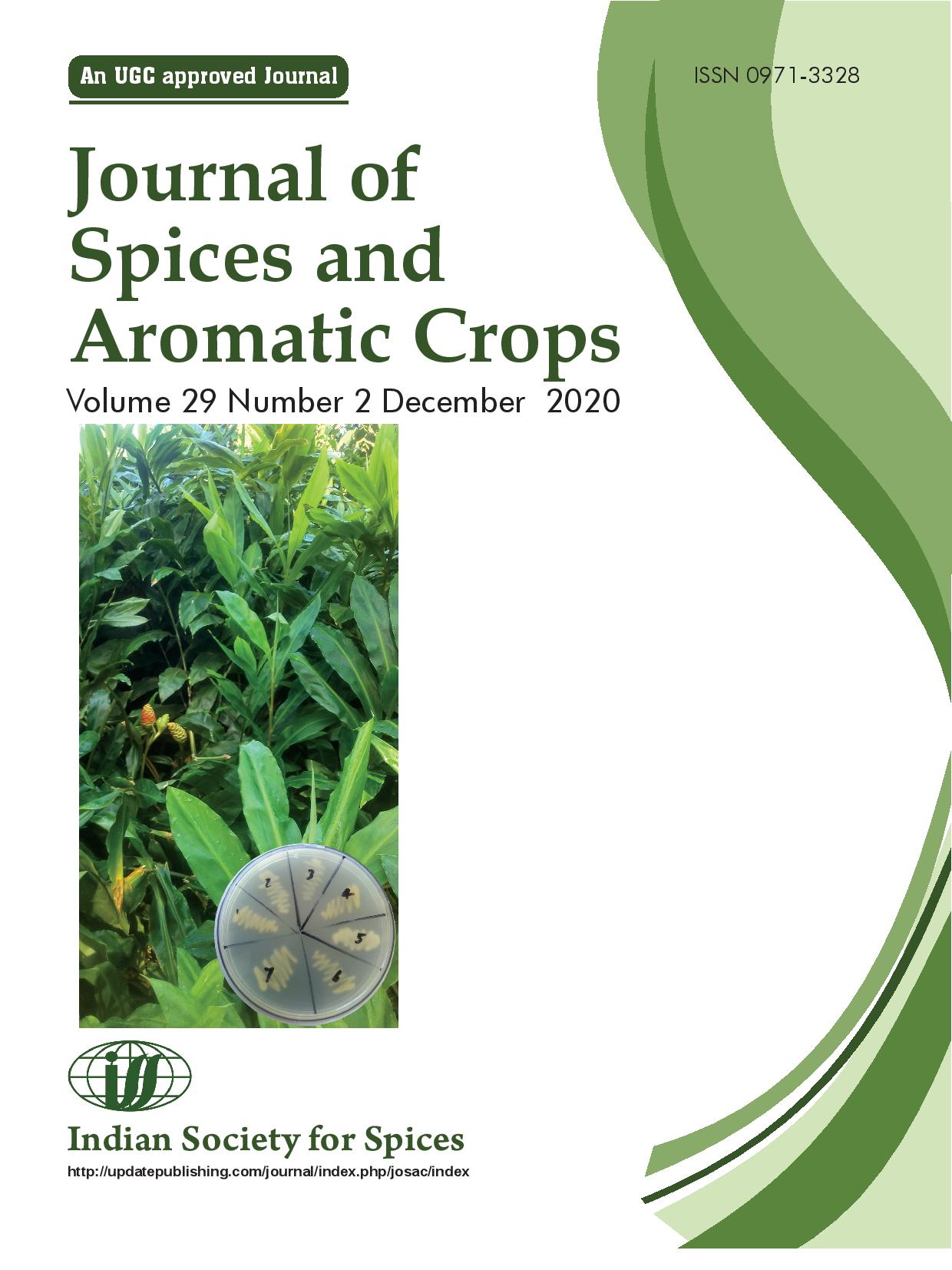Screening small cardamom (Elettaria cardamomum Maton) field gene bank accessions for phenotypic characters, yield potential and disease resistance
DOI:
https://doi.org/10.25081/josac.2020.v29.i2.6406Keywords:
cardamom, field gene bank, characterization, yield, rhizome rot, leaf blightAbstract
Evaluation of 117 field gene bank accessions of small cardamom for phenotypic characters along with yield potential and disease resistance (rhizome rot and leaf blight) at ICAR-Indian Institute of Spices Research Regional Station, Appangala revealed significant variation with respect to phenotypic characters. The highest plant height (350 cm) and number of bearing tillers (36.4) were recorded in the accessions, field gene bank (FGB) 65 and FGB 16, respectively. The highest fresh weight of capsules (399.61 g) and maximum number of capsules (244.20) plant-1 were recorded in the accession, FGB 13. Further, based on screening for disease resistance, 35 and 15 accessions of cardamom were identified as resistant to leaf blight and highly resistant to rhizome rot, respectively. Based on the multivariate cluster analysis, 117 FGB accessions were classified into 5 clusters viz., clusters 1 and 2 encompassing equal number of accessions (44), cluster 3 with one accession (FGB 10), clusters 4 and 5 with 8 and 20 accessions, respectively.
Downloads
References
Biju C N, Peeran M F, Gowri R, Praveena R, Sharon A & Ankegowda S J 2018 Epidemiological parameters to delineate weather-disease interactions and host plant resistance against leaf blight in small cardamom (Elettaria cardamomum Maton). J. Spices Arom. Crops 27: 22–31.
Chethana Chabanahalli Somashekar, Chowdappa Pallem, Biju Chakkiyanickal Narayanan, Praveena Ravindran & Sujatha Annaiah Mukkatira 2016 Molecular and phenotypic characterization revealed six Colletotrichum species responsible for anthracnose disease of small cardamom in South India. European J. Plant Pathol. 146: 465–481.
Govindaraju C, Thomas J & Sudharsan M R 1996 Chenthal disease of cardamom caused by Colletotrichum gloeosporioides Penz. and its management. In: Mathew N M & Jacob C K (Eds.) Developments in Plantation Crop Research (pp.255–259), Allied Publ., New Delhi.
Joseph T & Suseela Bai R 1995 Fungal and bacterial diseases of cardamom (Elettaria cardamomum Maton) and their management. J. Spices Arom. Crops 4: 24–31.
Miniraj N, Murugan M & Carmel Rani Joseph 2000 Evaluation of cardamom (Elettaria cardamomum Maton) germplasm. J. Spices Arom. Crops 9: 55–56.
Prasath D & Venugopal M N 2004 Genetic diversity and conservation of cardamom (Elettaria cardamomum Maton) in India. Plant Genet. Resour. Newslet. 138: 55–60.
Praveena R, Biju C N, Senthil Kumar R, Darshana C N & Jashmi K C 2013 Preliminary evaluation of cardamom accessions against leaf blight/Chenthal disease. Indian Phytopathol. 66: 112–113.
Senthil Kumar R, Prasath D, Sharon Aravind, Leela N K, Venugopal M N, Ankegowda S J, Biju C N & Anandaraj M 2017 Evaluation of elite cardamom (Elettaria cardamomum) genotypes for yield, quality and resistance to Cardamom mosaic virus. J. Plant. Crops 45: 129–134.
Senthil Kumar R, Sharon Aravind, Biju C N & Ankegowda S J 2018 Characterization of genotypes of small cardamom (Elettaria cardamomum Maton) for yield parameters and disease resistance. J. Plant. Crops 46: 143–146.
Thomas J & Bhai R S 2002 Diseases of cardamom (Fungal, bacterial and nematode diseases). In: Ravindran P N & Madhusoodanan K J (Eds.) Cardamom - The genus Elettaria (pp.160–179). Taylor & Francis, London and New York.
Venugopal M N 2002 Viral diseases of cardamom. In: Ravindran P N & Madhusoodanan K J (Eds.) Cardamom - The genus Elettaria (pp.143–159). Taylor & Francis, New York.
Venugopal M N, Prasath D & Mulge R 2006 IISR Avinash – a rhizome rot resistant and high yielding variety of cardamom (Elettaria cardamomum Maton). J. Spices Arom. Crops 15: 14–18.






 .
.